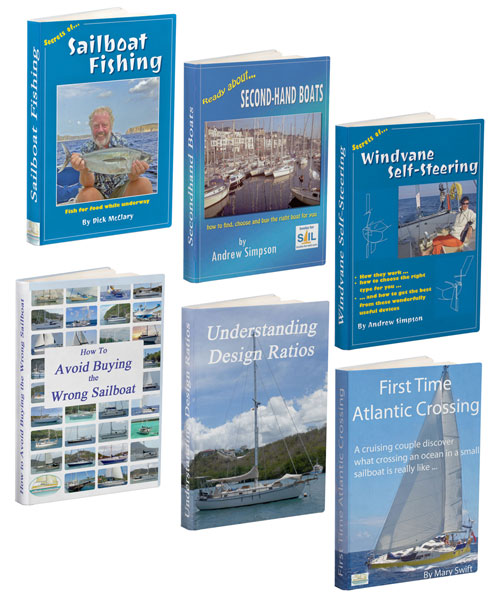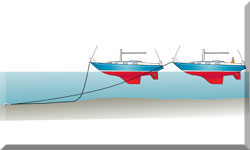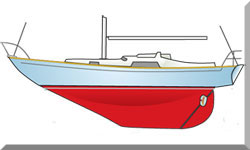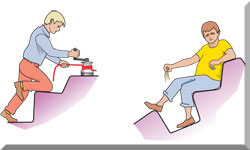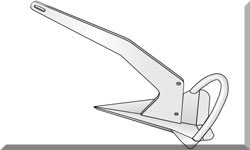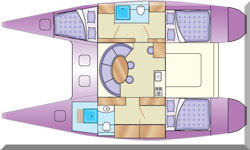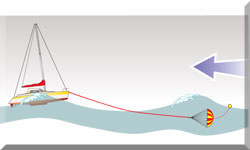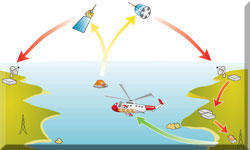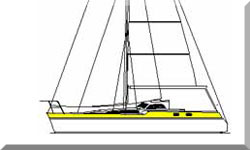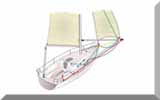Sail Safety: A Guide for Safe & Enjoyable Sailing
In a Nutshell: Sail Safety & The Prudent Sailor
Sail safety is something every sailor should take seriously. By focusing on prevention, preparation, and practice, you can really reduce the risks that come with sailing and make sure you and your crew have a safe and fun time on the water. It all comes down to a good routine of pre-sailing checks, being proactive with your sail handling, and knowing exactly what to do if things go wrong. Most accidents are caused by human error, a lack of preparation, and, most importantly, not wearing a life jacket. Having a safety-first mindset is the best way to protect your boat and, even more so, the people on board.
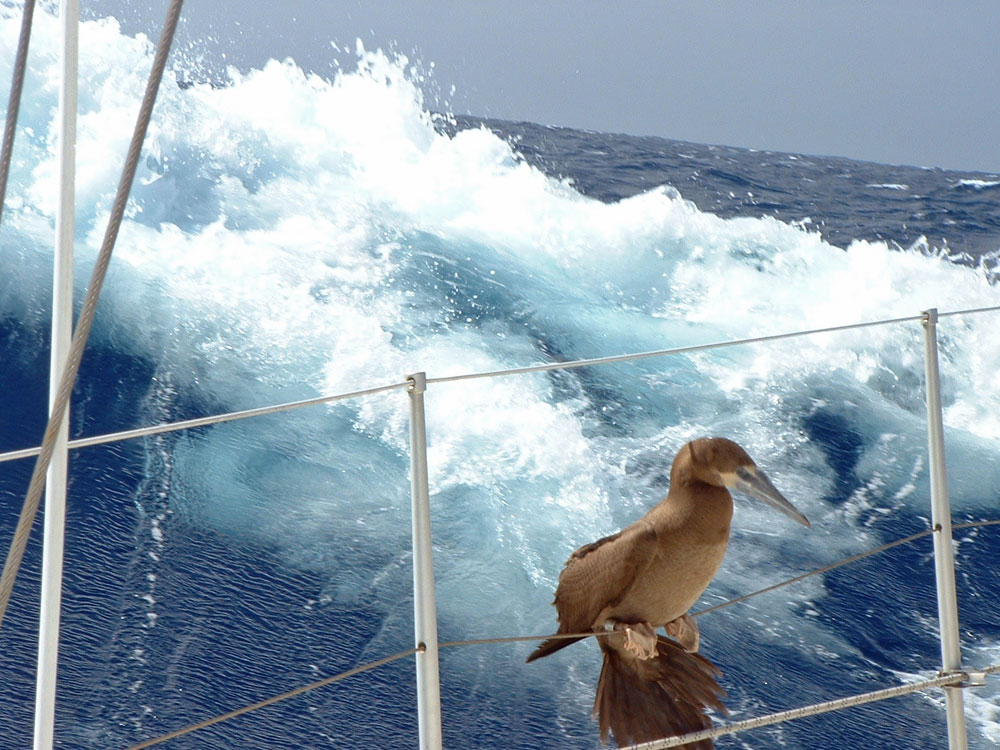 Take care—it can get rough out there...
Take care—it can get rough out there...Table of Contents
What are the Essential Pre-Sailing Checks?
Before you even think about casting off the dock lines, a thorough pre-sailing inspection is absolutely critical. This isn't just a quick look-over; it's a systematic review to make sure your boat is ready for the conditions ahead. A comprehensive check ensures your sails, rigging, and safety equipment are all in tip-top shape, setting the stage for a great day out.
Sails & Running Rigging
- Sails: Take a careful look at each sail for any signs of damage like tears, loose stitching, or chafe where the sail rubs against other parts of the boat. Check for delamination on laminate sails and inspect all the hardware like battens, slides, and rings for damage.
- Running Rigging: Examine every line—halyards, sheets, guys, topping lifts, and other control lines—for wear, fraying, or cuts. Pay close attention to areas that run through blocks or around winches. Don't hesitate to replace any line that looks questionable. A snapped halyard can turn a pleasant sail into a dangerous situation in an instant.
At this point you might want to take a look at our article Running Rigging & The Quest for Performance.
Sail Controls & Onboard Equipment
- Sail Controls: Test all your winches, clutches, blocks, and travellers to make sure they're working smoothly. Lubricate them if you need to. A jammed winch can make sail handling both difficult and dangerous.
- Safety Gear: Confirm you have a life jacket for every person on board, a fully stocked first-aid kit, a functioning VHF radio, flares for signalling distress, and a sharp knife for cutting lines in an emergency. Knowing where these items are is just as important as having them. As a seasoned sailor, I can tell you that having a well-organised, easily accessible ditch bag with all the essentials is a game-changer when seconds count.
Weather & Crew Briefing
- Weather Forecast: Always check the weather before you leave the dock. Understanding the wind conditions, sea state, and any potential hazards allows you to pick the right sails for the forecast.
- Crew Briefing: Even with an experienced crew, a briefing is a must. Go over sail handling procedures, emergency protocols (like man overboard drills), and the location of all safety equipment. Clear communication is the cornerstone of safe sailing.
How Do You Ensure Safe Sail Handling While Underway?
Once you're underway, staying in control and preventing accidents depends on sticking to a few key best practices. Being proactive with your sail handling not only improves performance but also significantly boosts the safety of your boat.
Best Practices
- Reefing Early: This is a fundamental principle of sail safety. Don't wait until the wind is too strong to reduce your sail area. Reefing early reduces stress on your sails and rigging, improves boat handling, and makes for a much more comfortable ride.
- Proper Sail Trim: Correctly trimmed sails reduce stress on the boat and prevent uncontrolled jibes or broaches. Understanding the basics of sail trim is vital for a secure and efficient passage.
- Avoid Flogging: Uncontrolled flapping can cause significant damage to the sailcloth and rigging. Minimise flogging by trimming sails properly and securing them when not in use. To learn more about how sail design influences a boat's handling and safety, read our comprehensive guide, "A Guide to Sailboat Sails: Powering Your Passage".
| Manoeuvre | Safety Best Practice | Reasoning |
|---|---|---|
| Hoisting/Lowering | Communicate clearly and have a designated person at the mast and the winch. | Prevents confusion and accidental releases. |
| Reefing | Always "point" the boat into the wind or bear away as needed to depower the sail. | Reduces tension on the sail, making it easier to handle safely. |
| Tacking | Yell "Tacking!" or "Coming about!" to alert the crew. | Ensures everyone is ready for the boom to swing. |
| Jibing | Yell "Jibing!" and control the boom with a preventer or vang. | Prevents an uncontrolled and dangerous swing of the boom. |
What are the Procedures for Heavy Weather & Emergencies?
A sailor has to be prepared for the unexpected. Knowing how to handle heavy weather and having a clear plan for emergencies can make all the difference when conditions get nasty.
Heavy Weather Sailing
- Preparation: If a storm is forecasted, prepare your boat in advance by reefing early, changing to storm sails, and securing all loose gear.
- Storm Sails: Know where your storm sails (storm jib and trysail) are and how to use them. Practise setting them in calmer conditions so you're ready when a real situation arises.
- Crew & Vessel: Make sure all crew members are wearing life jackets and harnesses, and that all hatches and ports are secured.
Emergency Procedures
- Man Overboard (MOB): Regular MOB drills are non-negotiable. Ensure everyone on board knows how to quickly drop sails, turn the boat, and get a person out of the water. I've conducted countless drills, and the muscle memory they create is invaluable in a real emergency.
- Sail & Rigging Damage: Carry sail repair tape and know how to use it for temporary fixes. For more serious rigging failures, have a plan for securing the mast and preventing further damage.
Understanding & Using Your Safety Equipment
Beyond simply having safety equipment onboard, knowing how to use it correctly and in a timely fashion is paramount. A quick, well-executed response in an emergency can be the difference between a close call and a serious incident.
Personal Flotation Devices (PFDs)
Not all life jackets are created equal. You should have a variety of PFDs on board to suit different conditions and needs.
- Foam-Filled Vests: These are reliable, don't need inflation, and are ideal for children and non-swimmers.
- Inflatable PFDs: These are compact and comfortable for active sailors. They come in two types: automatic (inflates on water immersion) and manual (requires a pull cord). For offshore sailing or single-handing, an automatic inflatable PFD with an integrated harness is an excellent choice. I've always preferred an automatic inflatable life jacket as it allows for full freedom of movement while providing maximum protection in an emergency.
Signalling Devices
In an emergency, your ability to signal for help is crucial.
Flares: There are three main types:
- Handheld Red Flare: Best for close-range distress signals at night.
- Parachute Flare: Shoots a bright red light high into the air, visible for many miles. Use this for long-range signalling both day and night.
- Orange Smoke Flare: For daytime use only, creating a highly visible orange smoke signal.
EPIRBs & PLBs: An Emergency Position-Indicating Radio Beacon (EPIRB) is a life-saving device that, when activated, transmits a signal to search and rescue services via satellite, giving your precise location. A Personal Locator Beacon (PLB) is a smaller, personal version, carried by an individual. They're the ultimate back-up in a worst-case scenario.
Communication & Emergency Response
- VHF Radio: Your VHF radio isn't just for hailing other vessels; it's your primary tool for communicating with the coastguard. You must know how to issue a "Mayday" call for grave and imminent danger to life, and a "Pan-Pan" for an urgent but non-life-threatening situation.
- First-Aid Kit: Your kit should be robust and tailored to the marine environment. Beyond the basics, include supplies for motion sickness, sun protection, and a saline wash for eyes. Store it in a waterproof container in an easily accessible location.
- Emergency Knife: An emergency knife is a non-negotiable piece of equipment. It should be sharp, corrosion-resistant, and securely fastened to your person or in a dedicated sheath in the cockpit. This is vital for cutting a tangled line in a hurry, for example, if a sheet gets in the turns around a winch—as "riding turn".
What About the Risks & Statistics?
While sailing is generally considered a safe activity, understanding the statistics and common risks can inform your safety practices. The most comprehensive data suggests that human error and a lack of preparation are the primary culprits in incidents.
Fatality & Injury Statistics
While it's hard to get exact data, studies, like those from the US Coast Guard, show that sailing is a relatively safe sport with a fatality rate comparable to alpine skiing.
- Fatality Rate: The fatality rate is around 1.19 deaths per million sailing days.
- Common Causes: A significant majority of deaths are due to falling overboard, often when people aren't wearing a life jacket. Other factors include capsizing, collisions, and alcohol consumption.
- Injuries: Injuries are more common than deaths, with sprains, lacerations, and contusions being the most frequent.
The most critical takeaway is that a large percentage of sailing deaths could have been prevented by simply wearing a life jacket. This single action is arguably the most important element of personal sail safety.
This article was written by Dick McClary, RYA Yachtmaster and author of the RYA publications 'Offshore Sailing' and 'Fishing Afloat', member of The Yachting Journalists Association (YJA), and erstwhile member of the Ocean Cruising Club (OCC).
Frequently Asked Questions
What is the single most important safety rule in sailing?
What is the single most important safety rule in sailing?
Always wear a life jacket, especially when moving about on deck or in rough conditions. A life jacket dramatically increases your chances of survival if you fall overboard.
Should I have a designated knife on my person?
Should I have a designated knife on my person?
Yes. A sharp knife, easily accessible at all times, is essential for cutting lines quickly in an emergency, such as when a rope becomes tangled around the propeller or a sheet gets caught.
How do I know when to reef?
How do I know when to reef?
A good rule of thumb is to reef as soon as you think about it. If you're questioning whether you should reef, it's likely already time. Reefing early prevents the boat from becoming overpowered and difficult to control.
What is the most common sailing accident?
What is the most common sailing accident?
The most common accidents are falls and injuries sustained during sail handling, often due to a sudden or unexpected movement of the boom or lines.
Is sailing more dangerous than other sports?
Is sailing more dangerous than other sports?
Sailing is generally comparable in risk to other outdoor sports like alpine skiing or rock climbing. With proper training and equipment, the risks are manageable.
Resources Used
- US Coast Guard: Office of Boating Safety
- Royal Yachting Association (RYA)
- Yachting Journalists' Association (YJA)
Recent Articles
-
Hans Christian 43: Classic Bluewater Cruiser & Liveaboard Sailboat
Dec 10, 25 04:37 AM
Explore the Hans Christian 43: a legendary heavy-displacement, long-keel sailboat. Read our in-depth review of its specs, design ratios, and suitability for offshore cruising and living aboard. -
Planning Your Sailboat Liveaboard Lifestyle: An Ocean Sailor's Guide
Dec 06, 25 05:18 AM
Seasoned sailors share their methodical risk analysis for planning a secure Sailboat Liveaboard Lifestyle, covering financial, property, and relationship risks. -
Marine Cabin Heaters: The Expert’s Guide to Comfort & Safety at Sea
Dec 05, 25 06:52 AM
Choose the best Marine Cabin Heaters for your vessel. Expert advice on diesel, paraffin, and hot water systems for year-round cruising comfort.
